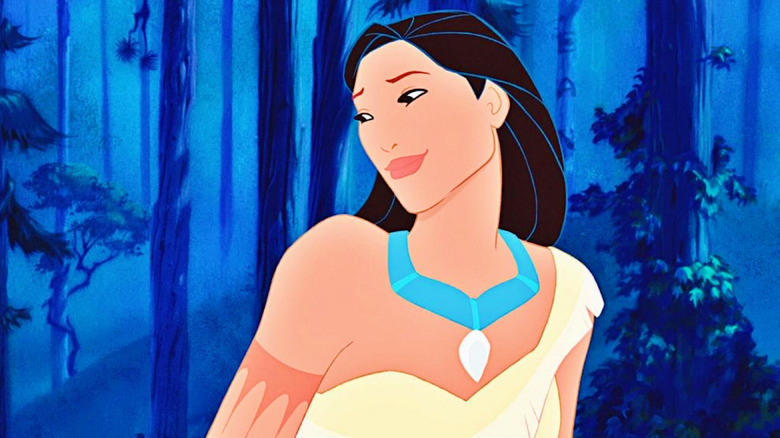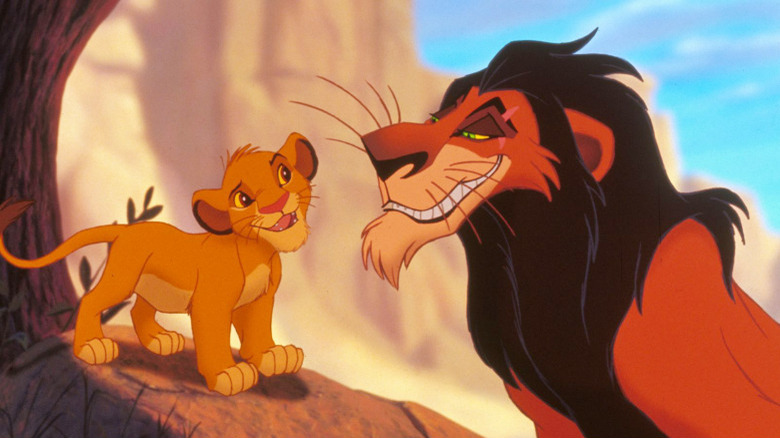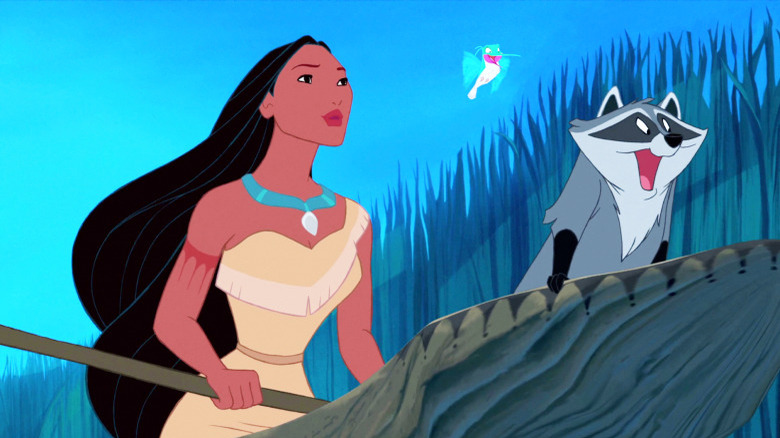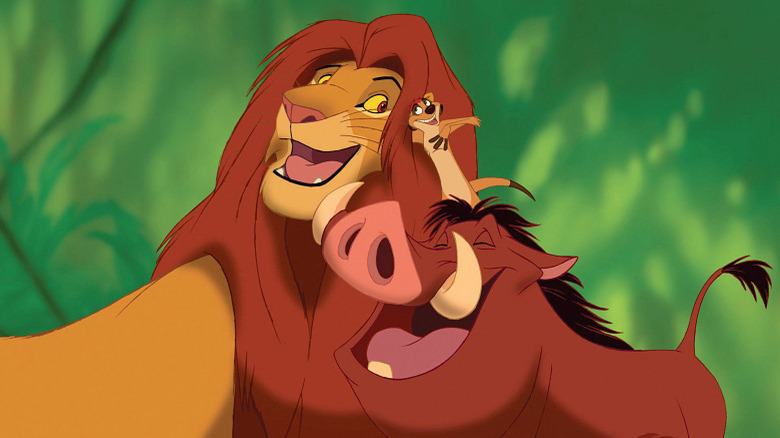Pocahontas Put The Lion King's Production At A Major Disadvantage
The Disney Renaissance was a time of great experimentation for the Mouse House — one that saw its animation division tackling all sorts of challenging material, from ancient legends spanning cultures around the world to decidedly dark and mature literary classics by Victor Hugo and Edgar Rice Burroughs. But with great daring comes the risk of committing equal-sized blunders, and that's just what the studio did when it decided to turn the tale of the real-life Indigenous American woman Pocahontas (a nickname passed down by her father) into an animated musical extravaganza.
That's not just the hindsight talking. "Pocahontas" earned a lackluster critical reception upon its theatrical release in 1995, with reviews arguing it was stunningly animated but otherwise lacking in personality. The film's reputation has only worsened over the decades thanks to its soft-peddling of the violence perpetuated by European colonialism, along with its rehashing of Indigenous American stereotypes (that and the casting of Mel Gibson as its hero, John Smith, but Disney's not to blame for that one). Adding insult to injury, the movie came out just a year after the Mouse House released one of its most beloved animated features of all time, "The Lion King."
Not without its flaws, either (the movie's weird political subtext and messaging borders on "Make the Pride Lands Great Again!"), "The Lion King" has stood the test of time far better than "Pocahontas." What's ironic is that Jeffrey Katzenberg, who was the head of Disney's film division at the time, saw the story of exiled prince Simba as the much bigger swing of the two, even going so far as to pit the movies against one another during their production.
The Lion King was an experiment
In a 2017 interview with Collider, "The Lion King" co-director Rob Minkoff talked about Jeffrey Katzenberg having very high hopes for "Pocahontas" at the time of its development, believing it could be a serious contender at the Academy Awards. "The Lion King," on the other hand, was described by Katzenberg as an "experiment" early on, which in its own way was liberating because, as Minoff reasoned, it freed him and his production team up to try and make something truly ground-breaking:
"Actually, Jeffrey Katzenberg very famously talked about Pocahontas and Lion King [while they] were in production at the same time. He said, 'Pocahontas is West Side Story meets Dances With Wolves.' He said, 'Lion King, on the other hand, is an experiment. So we don't really know.' But the fact that he allowed us to make a movie with no real precedent, with no real formula... Because in Hollywood particularly, people love a formula, right? It's a guidepost. If you understand the rules, it's like, that's what you're supposed to do. Suddenly, if you don't have a formula — everybody wants a formula, but if you don't have it, you really are forced to do something different."
Although it would end up bearing a disconcerting resemblance to older animated projects (not to mention a certain medieval Scandinavian myth and William Shakespeare play), "The Lion King" was otherwise something of a departure from Disney's formula at the time, like Minkoff pointed out. In another major shift from tradition, the movie was still in the middle of production when Disney got the ball rolling on "Pocahontas." This was all a bid on Katzenberg's part to get the studio releasing a new animated movie every year, which it had never done consistently up until that point.
'Pocahontas was a slightly favored production'
Speaking to Refinery29 in 2015, "The Lion King" and "Pocahontas" animator Tom Bancroft recalled how this led to a splitting of the ranks in Disney's animation department:
"To do that, the animation staff had to be broken into two groups. One group would work on the further-along-in-production Pocahontas, and the other group would work on the film that was just getting started in story (and I think still called just Lions), what would become The Lion King."
Animator Broose Johnson, who also worked on both films, described this as a necessary move, telling Refinery29 the extreme workload on previous Disney Renaissance movies had resulted in "heart attacks, broken homes, all sorts of stuff." Right off the bat, though, "The Lion King" was most animators' second choice, given directors Roger Allers and Rob Minkoff's lack of experience going in. By comparison, "Pocahontas" was being helmed by Mike Gabriel and Eric Goldberg, who had already co-directed "The Rescuers Down Under" and acted as the supervising animator on "Aladdin," respectively.
"So, the sense was that Pocahontas was a slightly favored production [because] it had two bigger directors," Johnson explained, adding that it "really wasn't a big deal" until Glen Keane — the supervisor animator for Ariel in "The Little Mermaid," Beast in "Beauty and the Beast," and Aladdin in, er, "Aladdin" — joined the "Pocahontas" crew. Calling him "the best animator in the studio at the time," animator Aaron Blaise (another artist who was involved with both "The Lion King" and "Pocahontas") told Refinery29 this was the tipping point for a lot of Disney personnel:
"... So right off the bat, everyone thought, 'Well if Keane is on Pocahontas, that must mean that's the more important film because they're really using their top dog for that'..."
I just can't wait to be king
Not helping, Aaron Blaise said "The Lion King" had been "struggling quite a bit" in early development:
"It was an original story kind of loosely based on Hamlet, but it was struggling. So when [The Lion King and Pocahontas] were going at the same time, Lion King hadn't really found its feet yet, and quite frankly, it was a bad movie. It just wasn't good yet."
Broose Johnson agreed with that sentiment, admitting the creatives on "The Lion King" felt the movie's now-legendary songs by Elton John "sounded too much like pop music" and didn't have "that Broadway flare" until combined with Hans Zimmer's score later on. This only further pushed animators in the direction of "Pocahontas," believing "The Lion King" was a flop in the making. But far from hurting the project, Tom Bancroft said this led to a "(friendly) rivalry" within the ranks of Disney's animators and pushed them to make both films better. Bancroft added:
"To make matters worse, at an animation staff update meeting for both films (about mid-way through Lion King), Jeffery Katzenberg told the crowd that Pocahontas was a 'home run' while Lion King 'would be a base hit.' That statement embittered the Lion King animators, directors, and story people and made them work even harder to make it a better film. Personally, I don't think it was a slip of the tongue. I think Jeffery did it on purpose."
Be that true or not, it was the creatives on "The Lion King" who would ultimately enjoy the last laugh. That's not to suggest "Pocahontas" was a total dud (it was still a box office hit and won two Academy Awards), but there's also no question which film is the true royalty of the Disney Renaissance.



